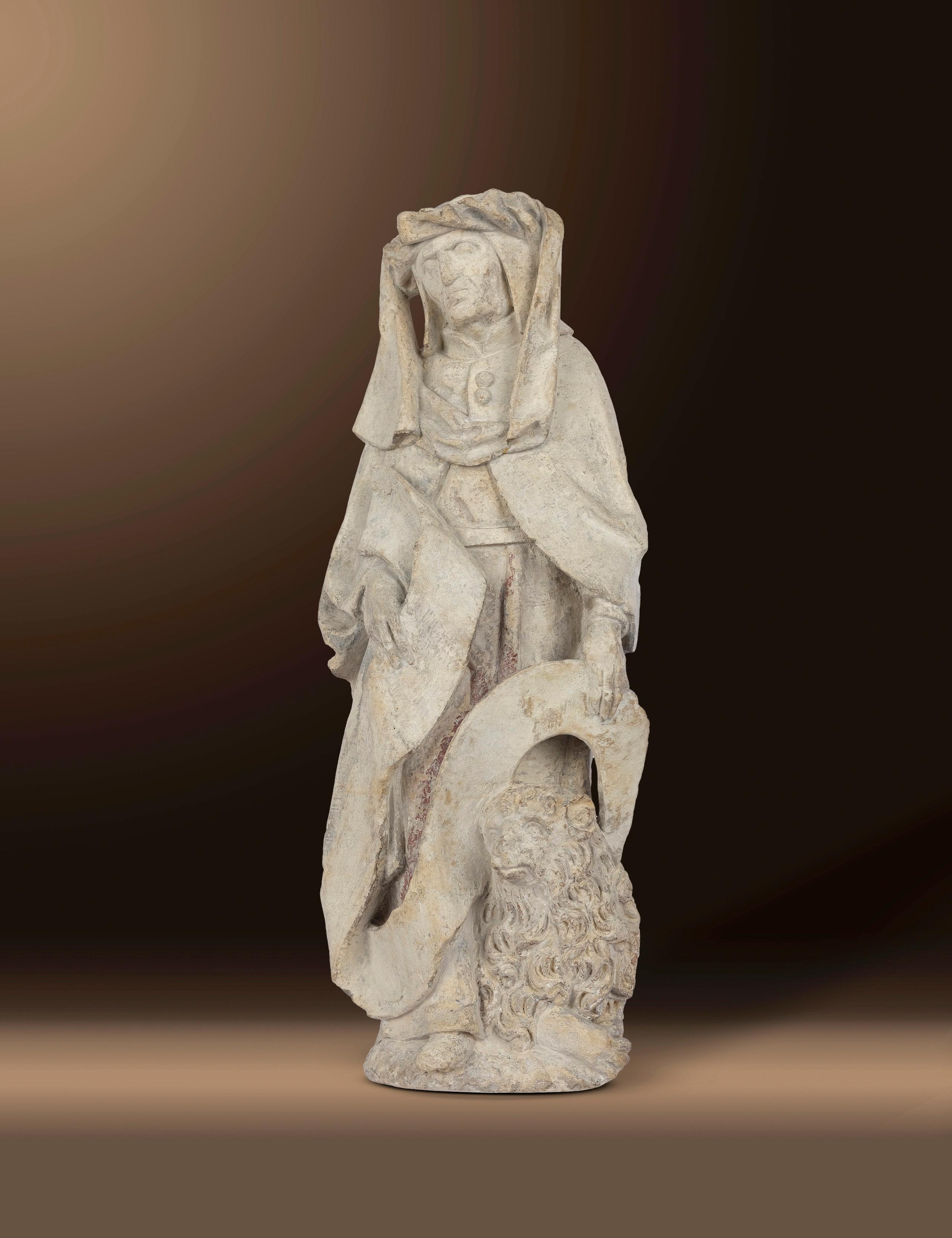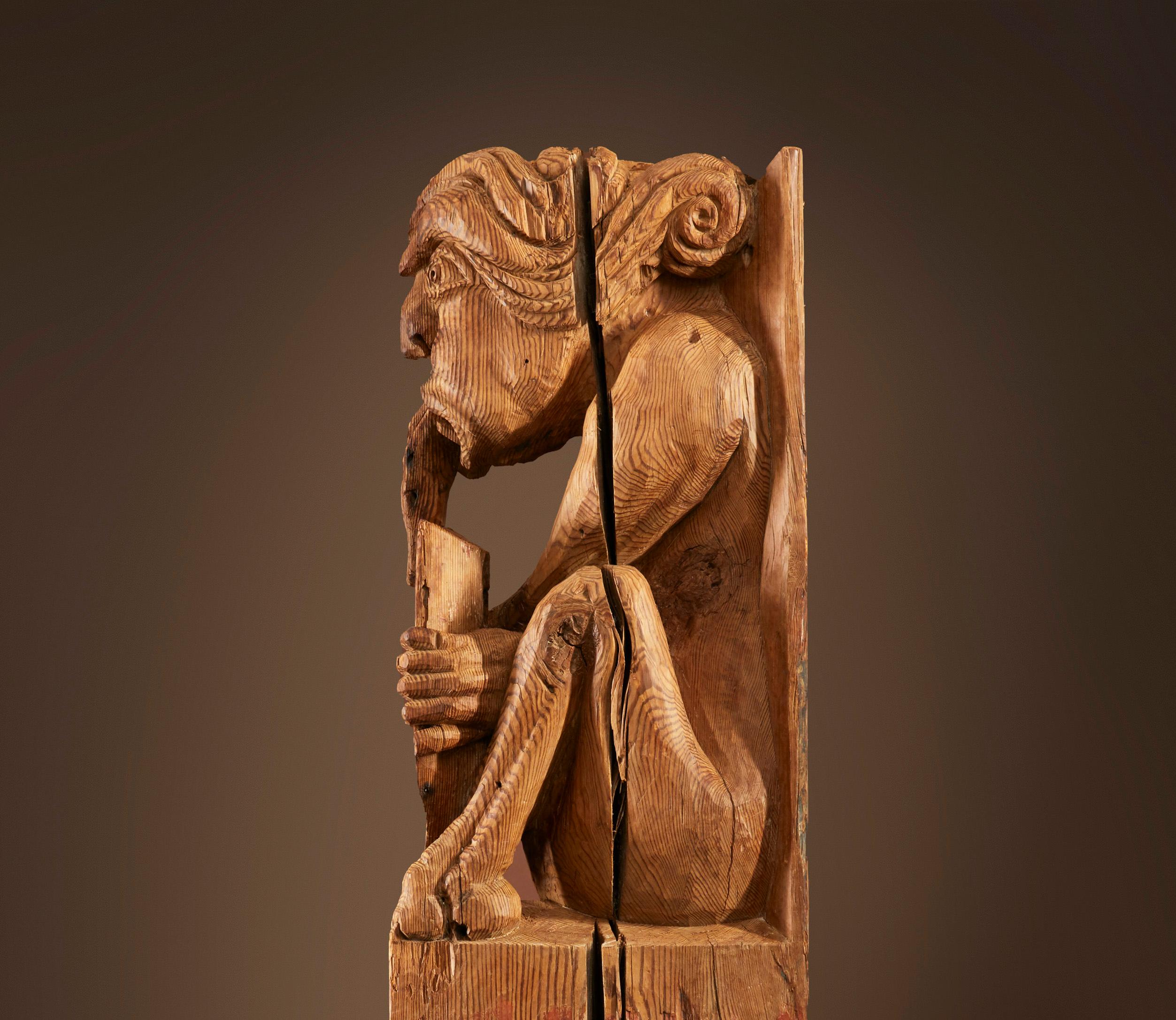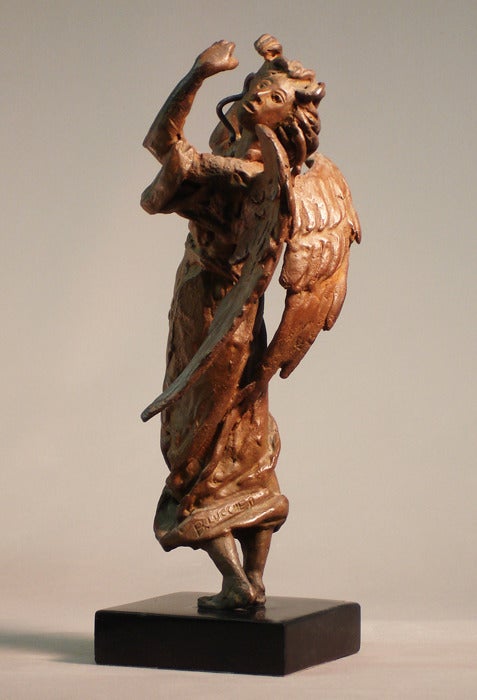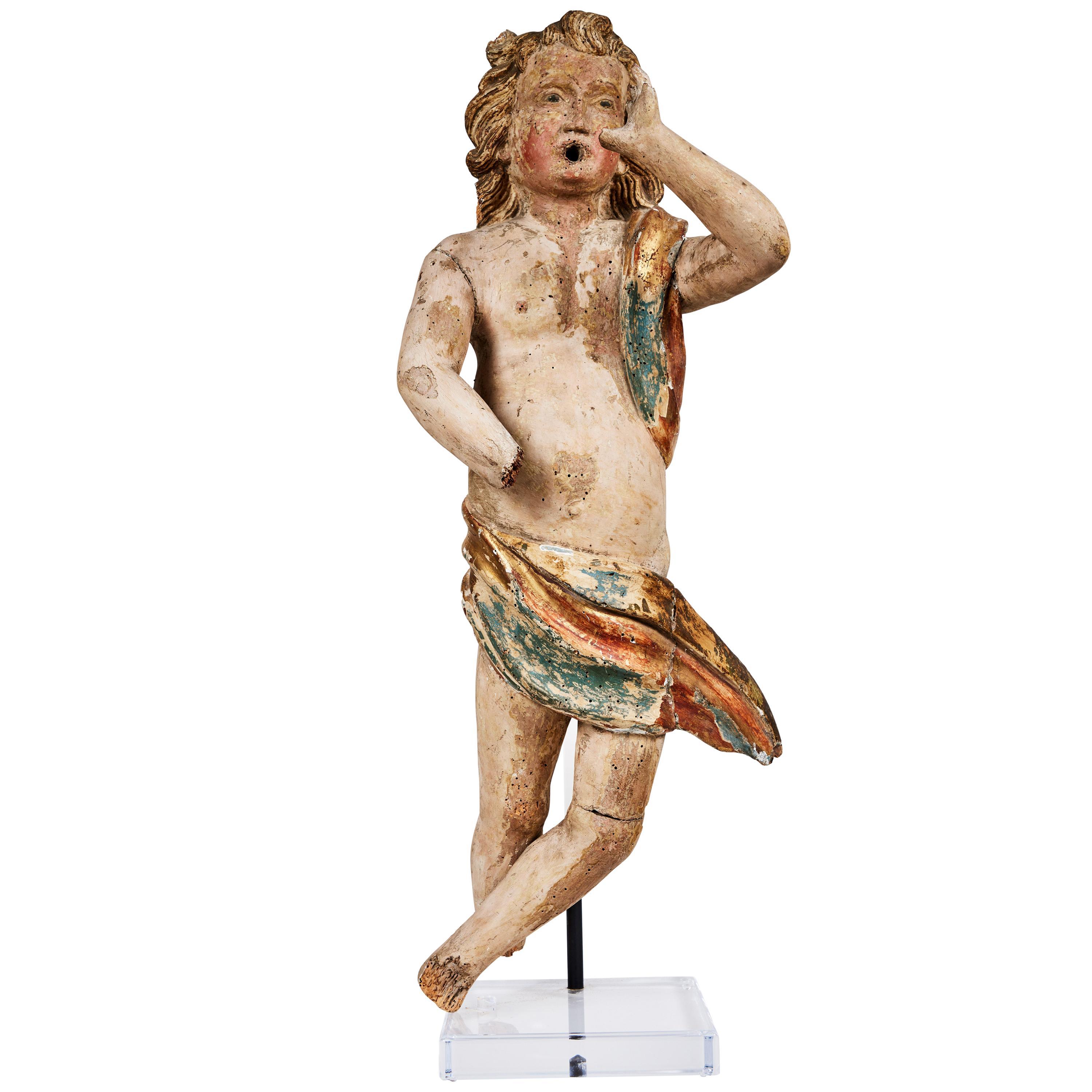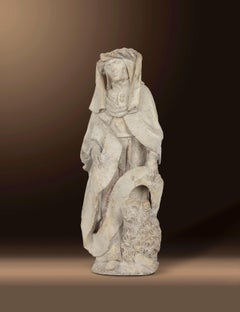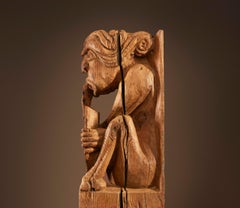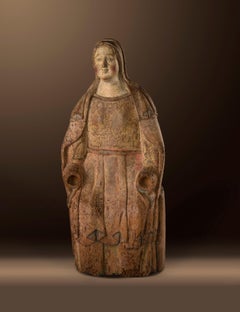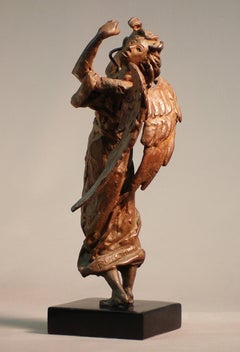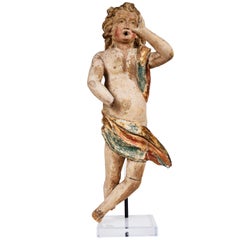Want more images or videos?
Request additional images or videos from the seller
1 of 6
UnknownStanding Engel1450/60
1450/60
$28,800
£22,117.16
€25,345.99
CA$40,543.29
A$45,417.44
CHF 23,666.63
MX$553,999.05
NOK 300,748.55
SEK 283,584.45
DKK 189,175.56
About the Item
Standing angel with banner
Flemish
Around 1450/60
Sandstone
60 x 21 x 15 cm
This museum figurine shows a standing angel with a banner in his right hand and a small box in his left. The youthful, ageless figure wears a coat held together with a triangular, floral brooch in front of the chest over a long robe. The angel’s gaze is directed forward, his head tilted slightly to the left. The elongated face is sculpted: the large almond-shaped eyes with accentuated upper and lower eyelids are alertly open and sharp eyebrows lead directly into the root of the nose. The straight nose above the pronounced mouth completes the idealized oval face of the angel and his calm, internalized facial expression. What is particularly remarkable, however, is the magnificent curls, which are only partially tamed by a simple headband. As if puffed up by the wind, the hair, which is sometimes streaked in parallel, sometimes wildly twisted and richly curled, stands out dynamically from the ears. The tilted head with these sideways protruding waves of hair thus conveys an immediate impression of movement. The physicality of the sculpture is expressed particularly through this organic, lifelike movement of the loosened hair.
The lively overall impression of the figure is further enhanced by the multiple rolled banners that the angel presents to the viewer. The outstretched palm of the right hand appears both intimate and confidential as well as mystically revealing. This banderole winds in gentle curves in front of the figure’s body, throws a fold over the second attribute in the angel’s left hand and falls downwards in a loose manner. The volute-shaped rolled up end of the banner clearly shows the fine texture of the banner and at the same time draws the viewer’s attention to the small cube-shaped box that the angel is holding in its slender, long-limbed fingers. The cube is decorated with a Gothic quatrefoil motif, which is often seen in the architectural tracery of windows, but was also often used to decorate caskets and other small treasures. The sweeping gestures in the presentation of the attributes suggest three-dimensionality, in contrast to the tubular folds at the base of the neck and the intricate draperies in flat and multiple overlapping garment sections. The soft curves of the folds give the impression that the clothing is made of a heavy fabric that falls diagonally down the front and is laid in several bowl folds under the right hand.
Overall, the sculptural work testifies to the highest artistic skill, which emphasizes the virtuosity of sculpture in its precious and representative overall impression. The memorable characteristics recognizable here can be seen in comparable pictorial works from Utrecht around the middle of the 15th century, when sculptural art – especially stone sculpture – was characterized by a remarkably high quality. Particularly noteworthy is the accentuated Utrecht head type with an elongated oval face, almond-shaped eyes with heavy lids and dense, vividly protruding tufts of hair framing the head. For example, the figure is comparable to a capital of an angel on the east side of the rood screen of the Joriskerk in Amersfoort (province of Utrecht) from the second quarter of the 15th century. Not only the physiognomy and hair, which in the comparative example stand somewhat more horizontally to one side, but also the garment puff above the girdle are similar. Even more related motifs, such as the cleverly placed bowl folds, can be found on the limestone figure of St. Mary. Agnes around 1450 (Centraal Museum Utrecht 1788-003). The hair is also fanned out at the sides of the head in a similar bouffant style. The situation is similar with the protective mantle image of a Saint. Ursula around 1460-70 made of oak (Amsterdam Begijnhof, chapel), whose hair appears to be “stacked” uniformly around her head. However, the hair in the comparative example appears less animated and therefore more restrained; the bowl folds also appear deeper and more angular than in the angel presented here. The angel can therefore be placed stylistically between Agnes and Ursula. Later works, such as a crest-bearing angel console made of oak around 1475 (Teutonic Knights, Ballei Utrecht, German House), show separate strands of hair running parallel downwards, which already appear to be covered in Mannerism. The hair on a limestone fragment of an angel from around 1480 (Leiden Stedelijk Museum de Lakenhal B145) is also more uniform and symmetrical than on the angel presented here. The same type of head can also be seen in two angels with the Arma Christi made of oak from around 1490 (Essen, Marks-Thomée Collection), although here the hair far exceeds the volume of the small face and the drapery is also much more angular.
In its choice of stone as a medium, in the execution of the softly curved drapery and in the representation of the characteristic head type, the angel refers to the sculptural art of Utrecht around the middle of the 15th century. The figure most probably originates from an important Utrecht workshop, which at this time created playful, lively depictions with varied, naturalistic hairstyles, which were not only adopted in modified form by Utrecht sculptors of the late Gothic period, but also by sculptors from other regions, such as Jan Borman, an important Flemish master carver of the late Gothic period and the Dutch Renaissance from Brussels.
- Creation Year:1450/60
- Dimensions:Height: 23.63 in (60 cm)Width: 8.27 in (21 cm)
- Medium:
- Period:
- Condition:
- Gallery Location:Wien, AT
- Reference Number:1stDibs: LU1143213902322
About the Seller
No Reviews Yet
Vetted Professional Seller
Every seller passes strict standards for authenticity and reliability
Established in 1986
1stDibs seller since 2019
Typical response time: 8 hours
- ShippingRetrieving quote...Shipping from: Wien, Austria
- Return Policy
Authenticity Guarantee
In the unlikely event there’s an issue with an item’s authenticity, contact us within 1 year for a full refund. DetailsMoney-Back Guarantee
If your item is not as described, is damaged in transit, or does not arrive, contact us within 7 days for a full refund. Details24-Hour Cancellation
You have a 24-hour grace period in which to reconsider your purchase, with no questions asked.Vetted Professional Sellers
Our world-class sellers must adhere to strict standards for service and quality, maintaining the integrity of our listings.Price-Match Guarantee
If you find that a seller listed the same item for a lower price elsewhere, we’ll match it.Trusted Global Delivery
Our best-in-class carrier network provides specialized shipping options worldwide, including custom delivery.More From This Seller
View AllMaster Angel
Located in Wien, Wien
MASTER ANGEL
Museum sculpture of the master of Mauer
Austrian Danube Region
Around 1500/20
Lime wood, carved full round
Height 55 cm
Provenance:
Hofstätter Collection, Vienna
The masterful sculpture was made in the workshop of the master of the altar of Mauer around 1500 in Lower Austria. It can be located in the context of the Danube school of the first third of the 16th century, was carved from limewood and is 55 cm tall. Since there are no attributes or context, it is an unknown figure of a carved altar.
The master of the altar of Mauer is an anonymous Gothic carver who was active between 1500 and 1525 and received this so-called emergency name through the altar for the parish and pilgrimage church of Mauer near Melk. This winged altar was probably commissioned by Göttweig Abbey in the 1470s and is made of lime wood. It shows an expression in the transition from late Gothic to early Renaissance and is considered the most important carved altar in Lower Austria, created between 1510-15.
The figure presented here is very related in its design to the figures of the altar of Mauer. In lively-moving form, the male figure turns his upper body to the right, with his head pointing upward, probably toward the sky. The right leg in lunge emerges from under the frock...
Category
16th Century Figurative Sculptures
Materials
Wood
Hl. Hieronymus
Located in Wien, Wien
St. Jerome
347 Stridon, Croatia - 420 Bethlehem
Around 1500/20
Limestone
Remains of the original polychromy
Height 45 cm
The man with the holy name!
347 Stridon, Croation – 420 Be...
Category
16th Century Figurative Sculptures
Materials
Limestone
Apotropäische Teufelsfigur
Located in Wien, Wien
APOTROPAIC DEVIL FIGURE
Romansh
South Tyrol or Grisons
Around 1120/50
Carved pine wood
Original version
Height 151 cm
This singular figure is a demonic, devil-like figure carved fro...
Category
15th Century and Earlier Figurative Sculptures
Materials
Wood
Sedes Sapientiae
Located in Wien, Wien
Sedes Sapientiae
Pustertal um 1220/30
Weichholz/Lindenholz(?)geschnitzt
Reste von originaler Polychromie
Höhe 57 cm
Category
15th Century and Earlier Figurative Sculptures
Materials
Wood
Apostel group
Located in Wien, Wien
APOSTLE GROUP
ORIGINAL VERSION
Flemish/Brabant
Around 1500
Oak wood carved
Height 37.5 cm, width 12 cm,
Depth 12.5 cm
Category
15th Century and Earlier Figurative Sculptures
Materials
Wood
$19,800
Corpus Christi
Located in Wien, Wien
MUSEUM CORPUS CHRISTI
Spain/Catalonia or Asturias
Around 1250
Corpus hardwood, arms softwood
Remains of the original polychrome setting
Height 109.5...
Category
15th Century and Earlier Figurative Sculptures
Materials
Wood
You May Also Like
Angel
By Bruno Lucchesi
Located in Greenwich, CT
Unique bronze sculpture of an angel
Category
20th Century Figurative Sculptures
Materials
Bronze
Important Sculpture
Located in ROUEN, FR
"Important Sculpture
IMPORTANT SCULPTURE representing Saint Floran de Lorch in polychrome wood in its beautiful old polychromy. He is represented ...
Category
16th Century Figurative Sculptures
Materials
Wood
$7,979
18th Century, Heralding Angel Sculpture
Located in Los Angeles, CA
An iconic, hand carved, gessoed, painted, and parcel-gilt, Italian polychrome sculpture of tousle curled angel in windswept drapery. Beautiful expression and patina. Now mounted on a...
Category
1730s Figurative Sculptures
Materials
Paint, Wood
Peace
Located in PARIS, FR
Peace
by Jules COUTAN (1848-1939)
Bronze sculpture with a dark brown patina
Signed on the base " Jules Coutan "
Cast by " Thiébaut Frères Fondeurs Paris " (with the foundry stamp)
P...
Category
Late 19th Century French School Figurative Sculptures
Materials
Bronze
$12,058
Small Sculpture of an Angel
Located in Saint-Ouen, FR
SMALL SCULPTURE FIGURING AN ANGEL
ORIGIN : GERMANY
PERIOD : 15TH CENTURY
Height: 48,5 cm
Width : 20 cm
Depth : 12 cm
Category
Antique 15th Century and Earlier Figurative Sculptures
Materials
Wood
Pilgrim polychrome stone figure
Located in PARIS, FR
Pilgrim or saint Jacques figure in sculpted and polychromed limestone. He holds a calabash in his left hand. He probably held the pilgrim's staff in his missing right hand. Very beau...
Category
15th Century and Earlier Gothic Figurative Sculptures
Materials
Limestone
More Ways To Browse
Large Standing Sculpture
15th Century Stone Sculpture
Mantle Sculpture
Gothic Angels
Antique Lead Sculpture
Flemish Sculpture
Tubular Sculpture
Antique Stone Window
Antique Window Box
Antique Stand Fan
Fan Brooch
Antique Oval Window
Antique German Brooches
Stacked Bowl
Quatrefoil Gothic
Antique Stone Capital
15th Century Oak
Dutch Oak Chest
